Microsoft Office 2010 theme by Holland M.
Download: MicrosoftOffice2010.p3t
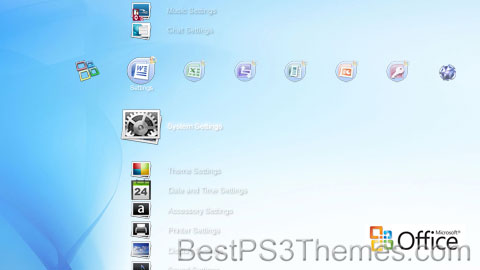 s
s
 | |
 Microsoft Office 2010 applications from top left to bottom right: Word, Excel, PowerPoint and OneNote which collectively make up the Home and Student edition. | |
| Developer(s) | Microsoft |
|---|---|
| Initial release | June 15, 2010[1] |
| Final release | Service Pack 2 (14.0.7268.5000)
/ April 15, 2021[2] |
| Operating system | Windows XP SP3 or later Windows Server 2003 SP2 or later[3][4] |
| Platform | IA-32 and x64 |
| Predecessor | Microsoft Office 2007 (2007) |
| Successor | Microsoft Office 2013 (2013) |
| Available in | 40 languages[5] |
List of languages English, Arabic, Bulgarian, Chinese (Simplified), Chinese, Croatian, Czech, Danish, Dutch, Estonian, Filipino, Finnish, French, German, Greek, Hebrew, Hindi, Hungarian, Italian, Japanese, Kazakh, Korean, Latvian, Lithuanian, Norwegian (Bokmål), Polish, Portuguese (Brazil), Portuguese (Portugal), Romanian, Russian, Serbian, Slovak, Slovenian, Spanish, Swedish, Thai, Turkish, Ukrainian | |
| Type | Office suite |
| License | Trialware |
| Website | products |
Microsoft Office 2010 (codenamed Office 14[6]) is a version of Microsoft Office for Microsoft Windows unveiled by Microsoft on May 15, 2009, and released to manufacturing on April 15, 2010,[1] with general availability on June 15, 2010.[7] The macOS equivalent, Microsoft Office 2011 for Mac was released on October 26, 2010.
Office 2010 introduces user interface enhancements including a Backstage view that consolidates document management tasks into a single location. The ribbon introduced in Office 2007 for Access, Excel, Outlook, PowerPoint, and Word is the primary user interface for all applications in Office 2010 and is now customizable.[8][9][10] Collaborative editing features that enable multiple users to share and edit documents;[11] extended file format support;[6] integration with OneDrive and SharePoint;[11] and security improvements such as Protected View, a sandbox to protect users from malicious content[12] are among its other new features. It debuted Office Online, free Web-based versions of Excel, OneNote, PowerPoint, and Word.[13][14][15] A new Office Starter 2010 edition replaces Microsoft Works.[16][17][18] Office Mobile 2010, an update to Microsoft's mobile productivity suite was released on May 12, 2010 as a free upgrade from the Windows Phone Store for Windows Mobile 6.5 devices with a previous version of Office Mobile installed.[19][20][21]
Office 2010 is the first version of Office to ship in a 64-bit version.[22][23] It is also the first version to require volume license product activation.[24][25] Office 2010 is compatible with Windows XP SP3 and Windows Server 2003 SP2 through Windows 10 v1809 and Windows Server 2016.[26][27] It is the last version of Microsoft Office to support Windows XP SP3, Windows Server 2003 SP2, Windows Vista SP1–SP2 and Windows Server 2008.[28][29][30][31]
Reviews of Office 2010 were generally very positive, with praise to the new Backstage view, new customization options for the ribbon, and the incorporation of the ribbon into all programs.[32][33] Sales, however, initially were lower than those of its predecessor.[34] Despite this, Office 2010 was a success for Microsoft, surpassing the company's previous records for adoption,[35] deployment,[35] and revenue for Office.[36] As of December 31, 2011, approximately 200 million licenses of Office 2010 were sold,[37] before its discontinuation on January 31, 2013.[38]
Mainstream support for Office 2010 ended on October 13, 2015, and extended support ended on October 13, 2020, the same dates that mainstream and extended support ended for Windows Embedded Standard 7.[39] Office 2010 is the last version of Office that can be activated without enrolling in a Microsoft account; enrollment for activation is required starting with Office 2013.[40] On June 9, 2018, Microsoft announced that its forums would no longer include Office 2010 or other products in extended support among its products for discussions involving support.[41] On August 27, 2021, Microsoft announced that Outlook 2010 and Outlook 2007 would be cut off from connecting to Microsoft 365 Exchange servers on November 1, 2021.[42]
History and development[edit]
Development started in 2007 while Microsoft was finishing work on Office 12, released as Microsoft Office 2007. The version number 13 was skipped because of the fear of the number 13.[43] It was previously thought that Office 2010 (then called Office 14) would ship in the first half of 2009.[44]
On April 15, 2009, Microsoft confirmed that Office 2010 would be released in the first half of 2010. They announced on May 12, 2009, at a Tech Ed event, a trial version of the 64-bit edition.[45][46] The Technical Preview 1 (Version: 14.0.4006.1010) was leaked on May 15, 2009.[47]
An internal post-beta build was leaked on July 12, 2009. This was newer than the official preview build and included a "Limestone" internal test application (note: the EULA indicates Beta 2).[48] On July 13, 2009, Microsoft announced Office 2010 at its Worldwide Partner Conference 2009.
On July 14, 2009, Microsoft started to send out invitations on Microsoft Connect to test an official preview build of Office 2010.[49] On August 30, 2009, the beta build 4417 was leaked on the internet via torrents.[50]
The public beta was available to subscribers of TechNet, MSDN and Microsoft Connect users on November 16, 2009.[51] On November 18, 2009, the beta was officially released to the general public at the Microsoft Office Beta website, which was originally launched by Microsoft on November 11, 2009 to provide screenshots of the new office suite.[52] Office 2010 Beta was a free, fully functional version and expired on October 31, 2010.[53]
In an effort to help customers and partners with deployment of Office 2010, Microsoft launched an Office 2010 application compatibility program with tools and guidance available for download.[54] On February 5, 2010, the official release candidate build 4734.1000 was available to Connect and MSDN testers. It was leaked to torrent sites.[55] A few days after, the RTM Escrow build was leaked.
Microsoft announced the RTM on April 15, 2010, and that the final version was to have speech technologies for use with text to speech in Microsoft OneNote, Microsoft PowerPoint, Microsoft Outlook, and Microsoft Word. Office 2010 was to be originally released to business customers on May 12, 2010,[56] however it was made available to Business customers with Software Assurance on April 27, 2010, and to other Volume Licensing Customers on May 1.[57] MSDN and TechNet subscribers have been able to download the RTM version since April 22, 2010. The RTM version number is 14.0.4763.1000.[58][59] Office 2010 was launched for general customer availability on June 15, 2010.[7][60]
Service packs[edit]
| Service pack | Version number | Release date |
|---|---|---|
| Service Pack 1 (SP1) | 14.0.6029.1000[61] | November 17, 2010[62] |
| Service Pack 2 (SP2) | 14.0.7015.1000[61] | April 8, 2013[63] |
Microsoft released two service packs for Office 2010 that were primarily intended to address software bugs. Service Pack 1 (SP1) and Service Pack 2 (SP2) were released concurrently with updates for additional products including Office Online, SharePoint, and SharePoint Designer.[62][63]
On November 17, 2010, Microsoft invited a select number of testers at the Microsoft Connect Web portal to test SP1 Beta 1.[64][65] SP1 was released by Microsoft on June 27, 2011, and included compatibility, performance, security, and stability improvements. SP1 is a cumulative update that includes all previous updates, as well as fixes exclusive to its release;[62][66] a list of exclusive fixes was released by Microsoft.[67] SP1 also introduced additional features for Access, Excel, OneNote, Outlook, PowerPoint, and Word. As examples, OneNote 2010 SP1 introduced the ability to open notebooks stored in OneDrive directly from within the app itself, while Outlook 2010 SP1 introduced Microsoft 365 support.[66] With the release of SP1, the use of Office Online in Google Chrome and Internet Explorer 9 was officially supported by Microsoft for the first time.[68]
On April 8, 2013, a beta build of Office 2010 SP2 was released.[69] SP2 was a cumulative update officially released on July 16, 2013, and included all of the previously released compatibility, performance, stability, and security fixes, as well as numerous exclusive fixes;[63] a list of fixes exclusive to SP2 was released by Microsoft.[70] Microsoft claimed that with the release of SP2, Office 2010 would feature improved compatibility with Internet Explorer 10, Office 2013, and SharePoint 2013.[63][71] Because SP2 is cumulative, SP1 is not a prerequisite for its installation.[72]
New features[edit]
User interface[edit]
In both its client programs and in its Internet implementation, the design of Office 2010 incorporates features from SharePoint and borrows from Web 2.0 ideas.[73][74][75] Office 2010 is more "role-based" than previous versions of Microsoft Office, with specific features tailored to employees in "roles such as research and development professionals, sales people, and human resources."[75]
Backstage view[edit]
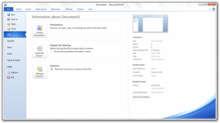
A new Backstage view interface replaces the Office menu introduced in Office 2007 and is designed to facilitate access to document management and sharing tasks by consolidating them within a single location.[76] In theatre, backstage refers to the area behind the stage where behind the scenes activities and preparations commence; the Backstage view is accordingly an interface dedicated to activities and preparations before saving or sharing a document.[77] Backstage consists of both a left-hand navigation pane and an adjacent main pane; the navigation pane includes a series of vertically arranged common commands to open or save files, and tabs that, when opened, expose document management tasks and contextual information within the main pane.[76][78] A customizable number of recently opened documents can also be displayed within the navigation pane.[79]
Tasks that are accessed via tabs in the main Backstage pane are categorized into separate groups that display contextual information related to app configurations, files, and tasks; each tab displays information relevant to that specific tab. On the Info tab in Word, for example, document metadata details are displayed within the Prepare for Sharing group to inform users of potentially personal information before the file is shared with other users,[80] whereas the Help tab displays Office 2010 version information and product licensing status.[81] In Office 2007, this information was included within separate locations.[80][81] From the Info tab, users can access revisions of currently open Excel, PowerPoint, and Word documents, as well as the latest unsaved version of a document that was previously closed.[82] Within the Print tab, Backstage also combines the previously separate print and print preview features by displaying printer tasks, settings, and a zooming user interface to preview the currently open document without the user having to open a dialog box.[83]
Backstage is extensible; developers can add their own commands, tabs, tasks, or related information.[84][85][86]
File tab[edit]
The File tab replaces the Office button introduced in Office 2007 and offers similar functionality. The previous Office button—a round button adorned with the Microsoft Office 2007 logo—had a different appearance from the ribbon tabs in the Office 2007 interface and was positioned away from them, with a target that extended toward the upper left corner of the screen in accordance with Fitts's law.[79][87] Microsoft stated this button enhanced the usability of Office, but many users saw it as "branding decoration, rather than a functional button." As a result, in Office 2010 it was replaced with a File tab that appears next to the other tabs in the ribbon instead of the upper left-hand corner of the screen.[79] The File tab is colored on a per-app basis (e.g., it is colored orange in Outlook). Opening the File tab displays the new Backstage view.[88]
Pasting options gallery[edit]
Office 2010 introduces a pasting options gallery on the ribbon, in the context menu, and in the object-oriented user interface that replaces the Paste Special dialog box and Paste Recovery feature seen in previous versions of Office. The gallery introduces Live Preview effects to the paste process when users position the mouse cursor over an option in the gallery so that the result of the process can be previewed before it is applied to the document; a tooltip with an associated description and keyboard shortcut for that option will also appear. If users position the mouse cursor over a gallery option in the context menu, the rest of the context menu becomes transparent so that it does not obstruct preview results within the document. To facilitate keyboard-based paste operations, users can navigate the gallery by using the arrow keys on a keyboard or press Ctrl after pressing Ctrl+V to display gallery options. Gallery options change based on the content in the clipboard and the app into which the content is pasted.[89]
Ribbon improvements[edit]
The ribbon introduced in Office 2007 is fully customizable and included in all programs in Office 2010.[8][9] Users can add or rename custom ribbon tabs or groups, add additional commands to the default tabs, and hide tabs that are not used. Users can also export or import any customization changes made to the ribbon to facilitate backups, deployment, or sharing, or reset all ribbon customizations.[90] The ribbon was also updated with a visible interface option to minimize it, which leaves only the tabs exposed.[91]
After the launch of Office 2010, Microsoft provided free downloads for a new Favorites tab that consolidated commands based on customer feedback regarding the most frequently used commands in all Office programs.[92]
Other UI changes[edit]
- The default color scheme in Office 2010 is silver instead of blue as in Office 2007 and now features a 5:1 contrast ratio to improve accessibility and readability.[88]
- All app icons have been redesigned in Office 2010. The new icons are based on colors that correspond to their respective programs, as per previous releases, with an increased emphasis on app letters.[88]
- The Office 2010 splash screen has been redesigned from the one seen in Office 2007 and animates when an app is launched.[88]
- OneNote and PowerPoint support mathematical equations through an Equation Tools contextual tab on the ribbon.[93][94]
- PowerPoint and Publisher include alignment guides so users can align objects to a grid.[94][95]
- Smart tags introduced in Office XP have been renamed as Actions and are now accessible from the context menu.[96]
File formats[edit]
Office 2010 includes updated support for ISO/IEC 29500, the International Standard version of Office Open XML (OOXML) file format.[6] Office 2010 provides read support for ECMA-376, read/write support for ISO/IEC 29500 Transitional, and read support for ISO/IEC 29500 Strict.[97] In its pre-release form, however, Office 2010 only supported the Transitional variant, and not the Strict.[98]
Office 2010 also continued support for OpenDocument Format (ODF) 1.1, which is a joint OASIS/ISO/IEC standard (ISO/IEC 26300:2006/Amd 1:2012 — Open Document Format for Office Applications (OpenDocument) v1.1).[6]
Document co-authoring[edit]
Office 2010 introduces co-authoring functionality in the Excel Web App, the OneNote Web App, and in the client versions of OneNote, PowerPoint, and Word for documents stored on SharePoint 2010 sites and for shared documents in OneDrive[11] and Microsoft 365.[99] A co-authoring session is automatically initiated when two or more users open the same document. From Backstage within Excel, OneNote, PowerPoint, and Word, users can also save documents directly to remote locations to facilitate remote access and co-authoring sessions. In the Excel Web App, the OneNote, and the OneNote Web App edits to a shared document in a co-authoring session occur on a sequential basis, in near real-time, as shared documents save automatically with each edit. In PowerPoint and Word, however, users must upload changes to the server by manually saving the shared document.[11]
During a co-authoring session the Excel Web App, PowerPoint, and Word denote how many co-authors are editing a document through a status bar icon that, when clicked in PowerPoint and Word, displays contact information including the presence of co-authors; the Info tab of Backstage also displays these details. When users open the name of a co-author, they can send email with an email client or start instant messaging conversations with each other if a supported app such as Skype for Business is installed on each machine. If a conflict between multiple changes occurs in PowerPoint or Word, sharers can approve or reject changes before uploading them to the server.[11]
In both OneNote and the OneNote Web App, users can view the names of co-authors alongside their respective edits to the content in a shared notebook, or create separate versions of pages for individual use. Edits made since a notebook was last opened are automatically highlighted, with initials of the co-author who made the edit displayed. In OneNote, co-authors can also search for all edits made by a specific co-author. OneNote 2010 notebooks can be shared with Office Mobile 2010 users on Windows Phone 7.[11] OneNote 2007 users can also participate in a co-authoring session with OneNote 2010 users if shared notebooks use the older OneNote 2007 file format; however, co-author search, and page versioning, and compatibility with the OneNote Web App will not be available.[100]
Installation and deployment[edit]
Office 2010 introduces a new Click-to-Run installation process based on Microsoft App-V Version 4 streaming and virtualization technology as an alternative to the traditional Windows Installer-based installation process for the Home and Student and Home and Business editions, and as a mandatory installation process for the Starter edition. Click-to-Run products install in a virtualized environment (a Q: partition) that downloads product features in the background after the programs have been installed so that users can immediately begin using the programs. The download process is optimized for broadband connections.[101]
During the Office 2010 retail lifecycle Microsoft, in collaboration with original equipment manufacturers (OEMs) and retail partners, introduced a Product Key Card licensing program that allowed users to purchase a single license to activate Home and Student, Home and Business, and Professional editions preinstalled on personal computers at a reduced cost when compared with traditional retail media.[102] Product Key Card versions are restricted to a single machine.[103]
Volume license versions of Office 2010 require product activation. Office 2007's product activation was only required for OEM or retail versions of the product.[24]
Security[edit]
Office File Validation[edit]
Office File Validation, previously included only in Publisher 2007 for PUB files has been incorporated into Excel, PowerPoint, and Word in Office 2010 to validate the integrity of proprietary binary file formats (e.g., DOC, PPT, and XLS) introduced in previous versions of Microsoft Office. When users open a document, the structure of its file format is scanned to ensure that it conforms with specifications defined by XML schema; if a file fails the validation process it will, by default, be opened in Protected View, a new read-only, isolated sandbox environment to protect users from potentially malicious content.[104] this design allows users to visually assess potentially unsafe documents that fail validation.[105] Microsoft stated that it is possible for documents to fail validation as a false positive. To improve Office File Validation, Office 2010 collects various information about files that have failed validation and also creates copies of these files for optional submission to Microsoft through Windows Error Reporting.[104] Users are prompted approximately every two weeks from the date of a failed validation attempt to submit copies of files or of other information for analysis; prompts include a list of files that will be submitted to Microsoft and require explicit user consent prior to submission. Administrators can disable data submission.[106]
On December 14, 2010, Microsoft announced it would backport Office File Validation to Office 2003 and Office 2007.[107][108] On April 12, 2011, it was backported as an add-in for Office 2003 SP3 and Office 2007 SP2, and on June 28, 2011, was made available through Microsoft Update.[109] Office File Validation in Office 2003 and Office 2007 differs from the version in Office 2010 as these two releases do not include the Protected View feature. When users attempt to open a document that fails validation, they must first agree to a warning prompt before it can be opened.[109] Additionally, the configuration options in these two releases are only made available through the Windows Registry,[110] whereas Office 2010 also provides Group Policy options.[104]
Protected View[edit]
Protected View, an isolated sandbox environment for Excel, PowerPoint, and Word, replaces the Isolated Conversion Environment update available for previous versions of Microsoft Office. When a document is opened from
Realistik
Realistik theme by Rews
Download: Realistik.p3t
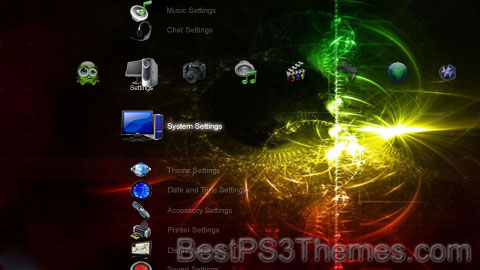
P3T Unpacker v0.12
Copyright (c) 2007. Anoop Menon
This program unpacks Playstation 3 Theme files (.p3t) so that you can touch-up an existing theme to your likings or use a certain wallpaper from it (as many themes have multiple). But remember, if you use content from another theme and release it, be sure to give credit!
Download for Windows: p3textractor.zip
Instructions:
Download p3textractor.zip from above. Extract the files to a folder with a program such as WinZip or WinRAR. Now there are multiple ways to extract the theme.
The first way is to simply open the p3t file with p3textractor.exe. If you don’t know how to do this, right click the p3t file and select Open With. Alternatively, open the p3t file and it will ask you to select a program to open with. Click Browse and find p3textractor.exe from where you previously extracted it to. It will open CMD and extract the theme to extracted.[filename]. After that, all you need to do for any future p3t files is open them and it will extract.
The second way is very simple. Just drag the p3t file to p3textractor.exe. It will open CMD and extract the theme to extracted.[filename].
For the third way, first put the p3t file you want to extract into the same folder as p3textractor.exe. Open CMD and browse to the folder with p3extractor.exe. Enter the following:
p3textractor filename.p3t [destination path]Replace filename with the name of the p3t file, and replace [destination path] with the name of the folder you want the files to be extracted to. A destination path is not required. By default it will extract to extracted.filename.
Tron Legacy
Tron Legacy theme by TrenchToast
Download: TronLegacy.p3t
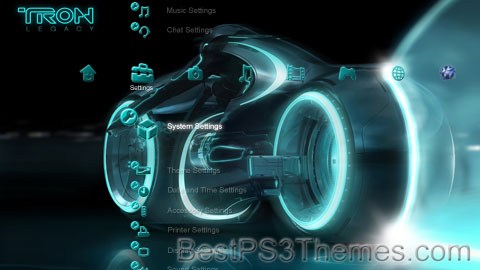
Redirect to:
- From a modification: This is a redirect from a modification of the target's title or a closely related title. For example, the words may be rearranged.
- Please note that there are many more specific templates. Please use {{R from alternative spelling}}, {{R from alternative hyphenation}}, {{R from alternative punctuation}}, {{R from alternative spacing}} and {{R from misquotation}} where relevant; see subcategories of Category:Redirects from modifications for other options (capitals, abbreviations, diacritics, plurals, stylizations, transliteration, ligatures, different parts of speech, etc.). If you are unsure which to use, this template is fine; someone will make it more specific later if necessary.
- In cases of modification from distinctly longer or shorter names, please use {{R from long name}} or {{R from short name}}, respectively. An abbreviation should be tagged with {{R from initialism}} or, if it can be spoken like a word such as NASA and RADAR, use {{R from acronym}}.
- Use this rcat instead of {{R from other capitalisation}} and {{R from plural}} in namespaces other than mainspace for those types of modification. This may also apply to several other subcategories of modification; please check those templates' output before saving if using outside of mainspace.
Resident Evil 5
Resident Evil 5 theme by Petro
Download: ResidentEvil5_8.p3t
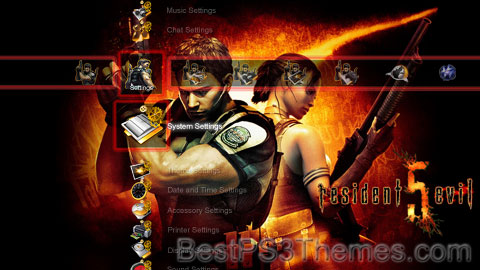
| Resident Evil 5 | |
|---|---|
 Cover art of the game, featuring Chris Redfield and Sheva Alomar | |
| Developer(s) | Capcom[a] |
| Publisher(s) | Capcom |
| Director(s) |
|
| Producer(s) |
|
| Designer(s) | Jiro Taoka |
| Programmer(s) | Soji Seta |
| Writer(s) |
|
| Composer(s) | Kota Suzuki |
| Series | Resident Evil |
| Engine | MT Framework |
| Platform(s) | |
| Release | March 5, 2009
|
| Genre(s) | Third-person shooter |
| Mode(s) | Single-player, multiplayer |
Resident Evil 5[b] is a 2009 third-person shooter video game developed and published by Capcom. It is a major installment in the Resident Evil series, and was announced in 2005—the same year its predecessor Resident Evil 4 was released. Resident Evil 5 was released for the PlayStation 3 and Xbox 360 consoles in March 2009 and for Windows in September 2009. It was re-released for PlayStation 4 and Xbox One in June 2016. The plot involves an investigation of a terrorist threat by Bioterrorism Security Assessment Alliance agents Chris Redfield and Sheva Alomar in Kijuju, a fictional region of West Africa. Chris learns that he must confront his past in the form of an old enemy, Albert Wesker, and his former partner, Jill Valentine.
The gameplay of Resident Evil 5 is similar to that of the previous installment, though it is the first in the series designed for two-player cooperative gameplay. It has also been considered the first game in the main series to depart from the survival horror genre, with critics saying it bore more resemblance to an action game. Motion capture was used for the cutscenes, and it was the first video game to use a virtual camera system. Several staff members from the original Resident Evil worked on Resident Evil 5. The Windows version was developed by Mercenary Technology.
Resident Evil 5 received a positive reception, despite some criticism for its control scheme. The game received some complaints of racism, though an investigation by the British Board of Film Classification found the complaints were unsubstantiated.[4] As of December 2023, when including the original, special and remastered versions, the game had sold 13.4 million units.[5] It is the best-selling game of the Resident Evil franchise when not including remakes,[c] and the original version remained the best-selling individual Capcom release until March 2018, when it was outsold by Monster Hunter: World. A sequel, Resident Evil 6, was released in 2012.
Plot[edit]
In 2009,[6] five years after the events of Resident Evil 4, Chris Redfield, now an agent of the Bioterrorism Security Assessment Alliance (BSAA), is dispatched to Kijuju in West Africa. He and his new partner Sheva Alomar are tasked with apprehending Ricardo Irving before he can sell a bio-organic weapon (BOW) on the black market. When they arrive, they discover that the locals have been infected by the parasites Las Plagas (those infected are called "Majini") and the BSAA Alpha Team have been killed. Chris and Sheva are rescued by BSAA's Delta Team, which includes Sheva's mentor Captain Josh Stone. In Stone's data Chris sees a photograph of Jill Valentine, his old partner, who has been presumed dead after a confrontation with Albert Wesker. Chris, Sheva and Delta Team close in on Irving, but he escapes with the aid of a hooded figure. Irving leaves behind documents that lead Chris and Sheva to marshy oilfields, where Irving's deal is to occur, but they discover that the documents are a diversion. When Chris and Sheva try to regroup with Delta Team, they find the team slaughtered by a BOW; Sheva cannot find Stone among the dead. Determined to learn if Jill is still alive, Chris does not report to headquarters.[7]
Continuing through the marsh, they find Stone and track down Irving's boat with his help. Irving injects himself with a variant of the Las Plagas parasite and mutates into a huge octopus-like beast. Chris and Sheva defeat him, and his dying words lead them to a nearby cave. The cave is the source of a flower used to create viruses previously used by the Umbrella Corporation, as well as a new strain named Uroboros. Chris and Sheva find evidence that Tricell, the company funding the BSAA, took over a former Umbrella underground laboratory and continued Umbrella's research. In the facility, they discover thousands of capsules holding human test subjects. Chris finds Jill's capsule, but it is empty. When they leave, they discover that Tricell CEO Excella Gionne has been plotting with Wesker to launch missiles with the Uroboros virus across the globe; it is eventually revealed that Wesker hopes to take a chosen few from the chaos of infection and rule them, creating a new breed of humanity. Chris and Sheva pursue Gionne but are stopped by Wesker and the hooded figure, who is revealed to be a brainwashed Jill. Gionne and Wesker escape to a Tricell oil tanker; Chris and Sheva fight Jill, subduing her and removing the mind-control device before she urges Chris to follow Wesker.[7]
Chris and Sheva board the tanker and encounter Gionne, who escapes after dropping a case of syringes; Sheva keeps several. When Chris and Sheva reach the main deck, Wesker announces over the ship's intercom that he has betrayed Gionne and infected her with Uroboros. She mutates into a giant monster, which Chris and Sheva defeat. Jill radios in, telling Chris and Sheva that Wesker must take precise, regular doses of a serum to maintain his strength and speed; a larger or smaller dose would poison him. Sheva realizes that Gionne's syringes are doses of the drug. Chris and Sheva follow Wesker to a bomber loaded with missiles containing the Uroboros virus, injecting him with the syringes Gionne dropped. Wesker tries to escape on the bomber; Chris and Sheva disable it, making him crash-land in a volcano. Furious‚ Wesker exposes himself to Uroboros and chases Chris and Sheva through the volcano. They fight him, and the weakened Wesker falls into the lava before Chris and Sheva are rescued by a helicopter, which is piloted by Jill and Stone. As a dying Wesker attempts to drag the helicopter into the volcano, Chris and Sheva fire rocket-propelled grenades at Wesker, killing him.[8] In the game's final cutscene, Chris wonders if the world is worth fighting for. Looking at Sheva and Jill, he decides to live in a world without fear.[7]
Gameplay[edit]

Resident Evil 5 is a third-person shooter with an over-the-shoulder perspective.[9] Players can use several weapons including handguns, shotguns, automatic rifles, sniper rifles, and grenade launchers, as well as melee attacks. Players can make quick 180-degree turns to evade enemies.[10] The game involves boss battles, many of which contain quick time events.[11]
As in its predecessor Resident Evil 4, players can upgrade weapons with money and treasure collected in-game and heal themselves with herbs, but cannot run and shoot at the same time.[11] New features include infected enemies with guns and grenades,[10] the ability to upgrade weapons at any time from the inventory screen without having to find a merchant, and the equipping of weapons and items in real-time during gameplay.[11] Each player can store nine items. Unlike the previous games, the item size is irrelevant; a herb or a grenade launcher each occupy one space, and four items may be assigned to the D-pad.[9] The game features puzzles, though fewer than previous titles.[12][13]
Resident Evil 5 is the first game in the Resident Evil series designed for two-player cooperative gameplay.[14] The player controls Chris, a former member of the fictional Special Tactics and Rescue Service (STARS) and member of the BSAA, and a second player can control Sheva, who is introduced in this game. If a person plays alone, Sheva is controlled by the game's artificial intelligence (AI). When the game has been completed once, there is an option to make Sheva the primary character.[11] Two-player mode is available online or split screen with a second player using the same console. A second player joining a split screen game in progress will make the game reload the last checkpoint (the point at which the game was last saved); the second player joining an online game will have to wait until the first player reaches the next checkpoint, or restarts the previous one, to play.[9] In split-screen mode, one player's viewpoint is presented in the top half of the screen, and the other in the bottom half, but each viewpoint is presented in widescreen format, rather than using the full width of the screen, resulting in unused space to the left and right of the two windows.[10] If one player has critical health, only their partner can resuscitate them, and they will die if their partner cannot reach them. At certain points, players are deliberately separated. Players can trade items during gameplay, although weapons cannot be traded with online players.[9] The game's storyline is linear, and interaction with other characters is mostly limited to cutscenes.[12][13]
A version of the Mercenaries minigame, which debuted in Resident Evil 3: Nemesis, is included in Resident Evil 5.[15] This minigame places the player in an enclosed environment with a time limit. Customized weapons cannot be used and players must search for weapons, ammunition, and time bonuses while fighting a barrage of enemies,[11] to score as many points as possible within the time limit.[16] The minigame multiplayer mode was initially offline only; a release-day patch needed to be downloaded to access the online multiplayer modes.[17] Mercenaries is unlocked when the game's story mode has been completed.[16]
Development[edit]

Resident Evil 5 was developed by Capcom and produced by Jun Takeuchi, who directed Onimusha: Warlords and produced Lost Planet: Extreme Condition. Keiji Inafune, promotional producer for Resident Evil 2 and executive producer of the PlayStation 2 version of Resident Evil 4, supervised the project. Production began in 2005 and at its peak, over 100 people were working on the project.[18] In February 2007, some members of Capcom's Clover Studio began working on Resident Evil 5 while others were working on Resident Evil: The Umbrella Chronicles, which debuted for the Wii.[19][20] Yasuhiro Anpo, who worked as a programmer on the original Resident Evil, directed Resident Evil 5.[21] He was one of several staff members who worked on the original game to be involved in Resident Evil 5's development.[22] The game's scenario was written by Haruo Murata and Yoshiaki Hirabayashi, based on a story idea by concept director Kenichi Ueda.[23] Takeuchi announced that the game would retain the gameplay model introduced in Resident Evil 4, with "thematic tastes" from both Resident Evil 4 and the original Resident Evil.[24]
While previous Resident Evil games are mainly set at night, the events of Resident Evil 5 occur almost entirely during the day. The decision for this was a combination of the game being set in Africa and advances in hardware improvements which allowed increasingly detailed graphics.[25] On the subject of changes to Jill and Chris's appearance, production director Yasuhiro Anpo explained that designers tried "to preserve their image and imagined how they would have changed over the passage of time". Their new designs retained the character's signature colors; green for Chris and blue for Jill. Sheva was redesigned several times during production, though all versions tried to emphasize a combination of "feminine attraction and the strength of a fighting woman".[26] The Majini were designed to be more violent than the "Ganado" enemies in Resident Evil 4.[27]
The decision for cooperative gameplay was made part-way through development, for a new experience in a Resident Evil game.[14] Despite initial concern that a second player would dampen the game's tension and horror, it was later realized that this could actually increase such factors where one player had to be rescued.[28] The decision to retain wide-screen proportions in two-player mode was made to avoid having the first player's screen directly on top of the second, which might be distracting, and the restriction on simultaneously moving and shooting was retained to increase player tension by not allowing them to maneuver freely. Takeuchi cited the film Black Hawk Down as an influence on the setting of Resident Evil 5 and his experience working on Lost Planet: Extreme Condition as an influence on its development.[14] When questioned as to why the game was not being released on the Wii, which was the most popular gaming console at that time, Takeuchi responded that although that may have been a good decision "from a business perspective", the Wii was not the best choice in terms of power and visual quality, concluding that he was happy with the console choices they had made.[29]
Resident Evil 5 runs on version 1.4 of Capcom's MT Framework engine[30] and scenes were recorded by motion capture. It was the first video game to use a virtual camera system,[31] which allowed the developers to see character movements in real time as the motion-capture actors recorded.[32] Actors Reuben Langdon, Karen Dyer and Ken Lally portrayed Chris Redfield, Sheva Alomar and Albert Wesker respectively.[33][34][35] Dyer also voiced Sheva,[36] while Chris's voice was performed by Roger Craig Smith.[37] Dyer's background training in circus skills helped her win the role of Sheva, as Capcom were searching for someone who could handle the physical skills her motion capture required. She performed her own stunts, and worked in production on the game for over a year, sometimes working 14 hours a day.[36] All of the human character motions were based on motion capture, while the non-human characters in the game were animated by hand.[38]
Kota Suzuki was the game's principal composer and additional music was contributed by Hideki Okugawa, Akihiko Narita and Seiko Kobuchi.[23] The electronic score includes 15 minutes of orchestral music, recorded at the Newman Scoring Stage of 20th Century Fox Studios in Los Angeles with the 103-piece Hollywood Studio Symphony. Other orchestral music and arrangements were by Wataru Hokoyama, who conducted the orchestra.[39] Capcom recorded in Los Angeles because they wanted a Hollywood-style soundtrack to increase the game's cinematic value and global interest. Resident Evil 5's soundtrack features an original theme song, titled "Pray",[40] which was composed by Suzuki and sung by Oulimata Niang.[41]
Marketing and release[edit]
Capcom announced Resident Evil 5 on July 20, 2005,[42] and the company showed a brief trailer for the game at the Electronic Entertainment Expo (E3) in July 2007.[43] The full E3 trailer became available on the Xbox Live Marketplace and the PlayStation Store that same month.[44][45] A new trailer debuted on Spike TV's GameTrailers TV in May 2008, and on the GameTrailers website.[46] A playable game demo was released in Japan on December 5, 2008, for the Xbox 360,[2] in North America and Europe for the Xbox 360 on January 26, 2009, and on February 2 for the PlayStation 3.[47] Worldwide downloads of the demo exceeded four million for the two consoles; over 1.8 million were downloaded between January 26 and January 29.[48]
In January 2009, D+PAD Magazine reported that Resident Evil 5 would be released with limited-edition Xbox 360 box art; pictures of the limited-edition box claimed that it would allow two to sixteen players to play offline via System Link.[49] Although Capcom said that their "box art isn't lying", the company did not provide details.[50] Capcom soon issued another statement that the box-art information was incorrect, and System Link could support only two players.[49] Microsoft released a limited-edition, red Xbox 360 Elite console which was sold with the game. The package included an exclusive Resident Evil theme for the Xbox 360 Dashboard[51] and a download voucher for Super Street Fighter II Turbo HD Remix from Xbox Live.[52]
Resident Evil 5 was released for PlayStation 3 and Xbox 360 in March 2009, alongside a dedicated Game Space on PlayStation Home. The space, Resident Evil 5 "Studio Lot" (Biohazard 5 "Film Studio" in Japan), had as its theme the in-game location of Kijuju. Its lounge offered Resident Evil 5-related items for sale, events and full game-launching support. Some areas of the space were available only to owners of Resident Evil 5.[53] A Windows version was released in September 2009. This version, using Nvidia's 3D Vision technology through DirectX 10, includes more costumes and a new mode in the Mercenaries minigame.[54][55] Resident Evil 5 was re-released on Shield Android TV in May 2016,[56] and was re-released on PlayStation 4 and Xbox One the following month, with a physical disc copy following in America that July.[57] It was also released for Nintendo Switch on October 29, 2019.[58]
Additional content[edit]
Shortly before the release of Resident Evil 5, Capcom announced that a competitive multiplayer mode called Versus would be available for download in several weeks.[59] Versus became available for download in Europe and North America on April 7, 2009, through the Xbox Live Marketplace and the PlayStation Store.[60] Versus has two online game types: "Slayers", a point-based game challenging players to kill Majini, and "Survivors", where players hunt each other while dodging and attacking Majini. Both modes can be played by two-player teams.[60] The Windows version of Resident Evil 5 originally did not support downloadable content (DLC).[61]
During Sony's press conference at the 2009 Tokyo Game Show Capcom announced that a special edition of the game, Biohazard 5: Alternative Edition, would be released in Japan for the PlayStation 3 in the spring of 2010.[62] This edition supports the PlayStation Move accessory and includes a new scenario, "Lost in Nightmares", where Chris Redfield and Jill Valentine infiltrate one of Umbrella Corporation co-founder Oswell E. Spencer's estates in 2006.[63] Another special edition of the game, Resident Evil 5: Gold Edition, was released for the Xbox 360 and PlayStation 3 in North America and Europe. Gold Edition includes "Lost in Nightmares" and another campaign-expansion episode, "Desperate Escape", where players control Josh Stone and Jill Valentine as they assist Chris and Sheva.[64] The edition also includes the previously released Versus mode, four new costumes and an alternate Mercenaries mode with eight new playable characters, new items and maps. Like Alternative Edition, Gold Edition supports the PlayStation Move accessory with a patch released on September 14, 2010.[65] The Xbox 360 version of Gold Edition came in a DVD with a token allowing free download of all DLC, while the PlayStation 3 version had all of the new content on a single Blu-ray disc.[65] On November 5, 2012, Resident Evil 5: Gold Edition was placed on the PlayStation Network as a free download for PlayStation Plus users during that month.[66]
As part of the game's conversion to Steamworks, Gold Edition was released for Microsoft Windows on March 26, 2015. Owners of the game from Steam or as a boxed retail Games for Windows – Live can acquire a free Steamworks copy of the base game and purchase the new Gold Edition content.[67] The Steamworks version did not allow the use of Nvidia's 3D Vision technology or fan modifications, though Capcom later confirmed a way to work around these issues.[68] In 2023, an update was released for the Windows version that removed Games for Windows – Live, thus restoring the split screen co-op feature to the game.[69]
Reception[edit]
| Aggregator | Score |
|---|---|
| Metacritic | PS3: 84/100[70] X360: 83/100[71] PC: 86/100[72] PS4: 69/100[73] XONE: 75/100[74] NS: 72/100[75] |
| Publication | Score |
|---|---|
| 1Up.com | B[76] |
| Edge | 7/10[77] |
| Eurogamer | 7/10[78] |
| Game Informer | 9.5/10[79] |
| GameRevolution | B+[80] |
| GameSpot | 8.5/10[9] |
| IGN | 9.0/10[11] |
| Official Xbox Magazine (US) | 9/10[81] |
Resident Evil 5 received generally favourable reviews, according to review aggregator Metacritic.[72][70][71] Reviewers praised the game's visuals and content. Corey Cohen of Official Xbox Magazine complimented the game's fast pace, and called the graphics gorgeous.[81] It was praised by Joe Juba and Matt Miller of Game Informer, who said that it had the best graphics of any game to date and that the music and voice acting helped bring the characters to life,[79] and Brian Crecente of Kotaku said it was one of the most visually stunning games he had ever played.[82] Adam Sessler of X-Play said the game's graphics were exceptional,[10] and Edge praised the gameplay as exhilarating and frantic.[77] For IGN, Ryan Geddes wrote that the game had a surprisingly high replay value,[11] and GameZone's Louis Bedigian said the game was "worth playing through twice in one weekend".[83]
While still giving favorable reviews of the game, several reviewers considered it t
BlazBlueSP
BlazBlueSP theme by ReikoAyanami
Download: BlazBlueSP.p3t
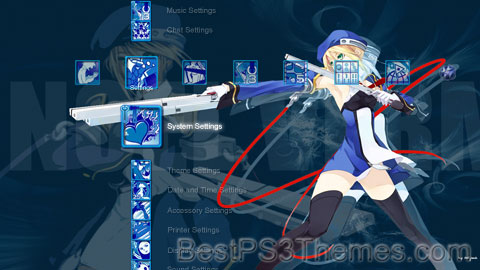
P3T Unpacker v0.12
Copyright (c) 2007. Anoop Menon
This program unpacks Playstation 3 Theme files (.p3t) so that you can touch-up an existing theme to your likings or use a certain wallpaper from it (as many themes have multiple). But remember, if you use content from another theme and release it, be sure to give credit!
Download for Windows: p3textractor.zip
Instructions:
Download p3textractor.zip from above. Extract the files to a folder with a program such as WinZip or WinRAR. Now there are multiple ways to extract the theme.
The first way is to simply open the p3t file with p3textractor.exe. If you don’t know how to do this, right click the p3t file and select Open With. Alternatively, open the p3t file and it will ask you to select a program to open with. Click Browse and find p3textractor.exe from where you previously extracted it to. It will open CMD and extract the theme to extracted.[filename]. After that, all you need to do for any future p3t files is open them and it will extract.
The second way is very simple. Just drag the p3t file to p3textractor.exe. It will open CMD and extract the theme to extracted.[filename].
For the third way, first put the p3t file you want to extract into the same folder as p3textractor.exe. Open CMD and browse to the folder with p3extractor.exe. Enter the following:
p3textractor filename.p3t [destination path]Replace filename with the name of the p3t file, and replace [destination path] with the name of the folder you want the files to be extracted to. A destination path is not required. By default it will extract to extracted.filename.
FinalFantasyVII Seph
FinalFantasyVII Seph theme by Twiztid
Download: FinalFantasyVIISeph.p3t
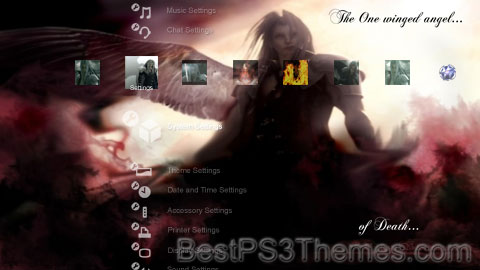
P3T Unpacker v0.12
Copyright (c) 2007. Anoop Menon
This program unpacks Playstation 3 Theme files (.p3t) so that you can touch-up an existing theme to your likings or use a certain wallpaper from it (as many themes have multiple). But remember, if you use content from another theme and release it, be sure to give credit!
Download for Windows: p3textractor.zip
Instructions:
Download p3textractor.zip from above. Extract the files to a folder with a program such as WinZip or WinRAR. Now there are multiple ways to extract the theme.
The first way is to simply open the p3t file with p3textractor.exe. If you don’t know how to do this, right click the p3t file and select Open With. Alternatively, open the p3t file and it will ask you to select a program to open with. Click Browse and find p3textractor.exe from where you previously extracted it to. It will open CMD and extract the theme to extracted.[filename]. After that, all you need to do for any future p3t files is open them and it will extract.
The second way is very simple. Just drag the p3t file to p3textractor.exe. It will open CMD and extract the theme to extracted.[filename].
For the third way, first put the p3t file you want to extract into the same folder as p3textractor.exe. Open CMD and browse to the folder with p3extractor.exe. Enter the following:
p3textractor filename.p3t [destination path]Replace filename with the name of the p3t file, and replace [destination path] with the name of the folder you want the files to be extracted to. A destination path is not required. By default it will extract to extracted.filename.
Disgaea Abcence of Justice
Disgaea Abcence of Justice theme by DragonNTwiztid
Download: DisgaeaAbsenceofJustice.p3t
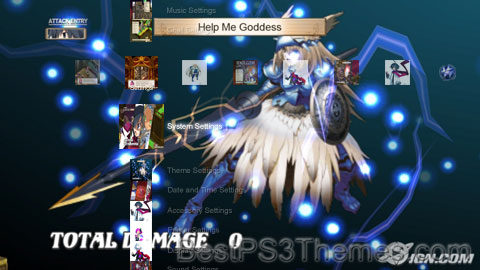
P3T Unpacker v0.12
Copyright (c) 2007. Anoop Menon
This program unpacks Playstation 3 Theme files (.p3t) so that you can touch-up an existing theme to your likings or use a certain wallpaper from it (as many themes have multiple). But remember, if you use content from another theme and release it, be sure to give credit!
Download for Windows: p3textractor.zip
Instructions:
Download p3textractor.zip from above. Extract the files to a folder with a program such as WinZip or WinRAR. Now there are multiple ways to extract the theme.
The first way is to simply open the p3t file with p3textractor.exe. If you don’t know how to do this, right click the p3t file and select Open With. Alternatively, open the p3t file and it will ask you to select a program to open with. Click Browse and find p3textractor.exe from where you previously extracted it to. It will open CMD and extract the theme to extracted.[filename]. After that, all you need to do for any future p3t files is open them and it will extract.
The second way is very simple. Just drag the p3t file to p3textractor.exe. It will open CMD and extract the theme to extracted.[filename].
For the third way, first put the p3t file you want to extract into the same folder as p3textractor.exe. Open CMD and browse to the folder with p3extractor.exe. Enter the following:
p3textractor filename.p3t [destination path]Replace filename with the name of the p3t file, and replace [destination path] with the name of the folder you want the files to be extracted to. A destination path is not required. By default it will extract to extracted.filename.
Dragons
Dragons theme by DragonNTwiztid
Download: Dragons.p3t
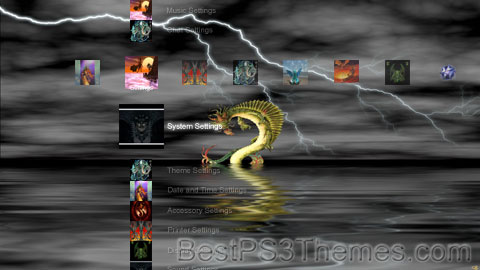
Redirect to:
This page is a redirect. The following categories are used to track and monitor this redirect:
|
Modern Warfare 2
Modern Warfare 2 theme by SAS_Sharpshooter
Download: ModernWarfare2_3.p3t
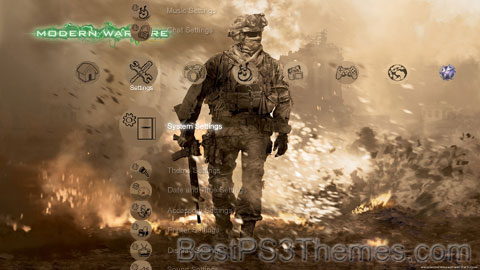
Redirect to:
This page is a redirect. The following categories are used to track and monitor this redirect:
|
Space
Space theme by DiSanti
Download: Space_4.p3t
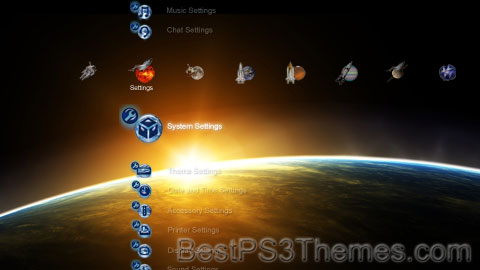

Space is a three-dimensional continuum containing positions and directions.[1] In classical physics, physical space is often conceived in three linear dimensions. Modern physicists usually consider it, with time, to be part of a boundless four-dimensional continuum known as spacetime.[2] The concept of space is considered to be of fundamental importance to an understanding of the physical universe. However, disagreement continues between philosophers over whether it is itself an entity, a relationship between entities, or part of a conceptual framework.
In the 19th and 20th centuries mathematicians began to examine geometries that are non-Euclidean, in which space is conceived as curved, rather than flat, as in the Euclidean space. According to Albert Einstein's theory of general relativity, space around gravitational fields deviates from Euclidean space.[3] Experimental tests of general relativity have confirmed that non-Euclidean geometries provide a better model for the shape of space.
Philosophy of space[edit]
Debates concerning the nature, essence and the mode of existence of space date back to antiquity; namely, to treatises like the Timaeus of Plato, or Socrates in his reflections on what the Greeks called khôra (i.e. "space"), or in the Physics of Aristotle (Book IV, Delta) in the definition of topos (i.e. place), or in the later "geometrical conception of place" as "space qua extension" in the Discourse on Place (Qawl fi al-Makan) of the 11th-century Arab polymath Alhazen.[4] Many of these classical philosophical questions were discussed in the Renaissance and then reformulated in the 17th century, particularly during the early development of classical mechanics.
Isaac Newton viewed space as absolute, existing permanently and independently of whether there was any matter in the.[5] In contrast, other natural philosophers, notably Gottfried Leibniz, thought that space was in fact a collection of relations between objects, given by their distance and direction from one another. In the 18th century, the philosopher and theologian George Berkeley attempted to refute the "visibility of spatial depth" in his Essay Towards a New Theory of Vision. Later, the metaphysician Immanuel Kant said that the concepts of space and time are not empirical ones derived from experiences of the outside world—they are elements of an already given systematic framework that humans possess and use to structure all experiences. Kant referred to the experience of "space" in his Critique of Pure Reason as being a subjective "pure a priori form of intuition".
Galileo[edit]
Galilean and Cartesian theories about space, matter, and motion are at the foundation of the Scientific Revolution, which is understood to have culminated with the publication of Newton's Principia Mathematica in 1687.[6] Newton's theories about space and time helped him explain the movement of objects. While his theory of space is considered the most influential in physics, it emerged from his predecessors' ideas about the same.[7]
As one of the pioneers of modern science, Galileo revised the established Aristotelian and Ptolemaic ideas about a geocentric cosmos. He backed the Copernican theory that the universe was heliocentric, with a stationary Sun at the center and the planets—including the Earth—revolving around the Sun. If the Earth moved, the Aristotelian belief that its natural tendency was to remain at rest was in question. Galileo wanted to prove instead that the Sun moved around its axis, that motion was as natural to an object as the state of rest. In other words, for Galileo, celestial bodies, including the Earth, were naturally inclined to move in circles. This view displaced another Aristotelian idea—that all objects gravitated towards their designated natural place-of-belonging.[8]
René Descartes[edit]
Descartes set out to replace the Aristotelian worldview with a theory about space and motion as determined by natural laws. In other words, he sought a metaphysical foundation or a mechanical explanation for his theories about matter and motion. Cartesian space was Euclidean in structure—infinite, uniform and flat.[9] It was defined as that which contained matter; conversely, matter by definition had a spatial extension so that there was no such thing as empty space.[6]
The Cartesian notion of space is closely linked to his theories about the nature of the body, mind and matter. He is famously known for his "cogito ergo sum" (I think therefore I am), or the idea that we can only be certain of the fact that we can doubt, and therefore think and therefore exist. His theories belong to the rationalist tradition, which attributes knowledge about the world to our ability to think rather than to our experiences, as the empiricists believe.[10] He posited a clear distinction between the body and mind, which is referred to as the Cartesian dualism.
Leibniz and Newton[edit]
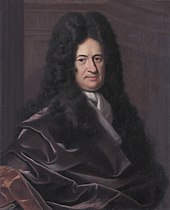
Following Galileo and Descartes, during the seventeenth century the philosophy of space and time revolved around the ideas of Gottfried Leibniz, a German philosopher–mathematician, and Isaac Newton, who set out two opposing theories of what space is. Rather than being an entity that independently exists over and above other matter, Leibniz held that space is no more than the collection of spatial relations between objects in the world: "space is that which results from places taken together".[11] Unoccupied regions are those that could have objects in them, and thus spatial relations with other places. For Leibniz, then, space was an idealised abstraction from the relations between individual entities or their possible locations and therefore could not be continuous but must be discrete.[12] Space could be thought of in a similar way to the relations between family members. Although people in the family are related to one another, the relations do not exist independently of the people.[13] Leibniz argued that space could not exist independently of objects in the world because that implies a difference between two universes exactly alike except for the location of the material world in each universe. But since there would be no observational way of telling these universes apart then, according to the identity of indiscernibles, there would be no real difference between them. According to the principle of sufficient reason, any theory of space that implied that there could be these two possible universes must therefore be wrong.[14]

Newton took space to be more than relations between material objects and based his position on observation and experimentation. For a relationist there can be no real difference between inertial motion, in which the object travels with constant velocity, and non-inertial motion, in which the velocity changes with time, since all spatial measurements are relative to other objects and their motions. But Newton argued that since non-inertial motion generates forces, it must be absolute.[15] He used the example of water in a spinning bucket to demonstrate his argument. Water in a bucket is hung from a rope and set to spin, starts with a flat surface. After a while, as the bucket continues to spin, the surface of the water becomes concave. If the bucket's spinning is stopped then the surface of the water remains concave as it continues to spin. The concave surface is therefore apparently not the result of relative motion between the bucket and the water.[16] Instead, Newton argued, it must be a result of non-inertial motion relative to space itself. For several centuries the bucket argument was considered decisive in showing that space must exist independently of matter.
Kant[edit]

In the eighteenth century the German philosopher Immanuel Kant published his theory of space as "a property of our mind" by which "we represent to ourselves objects as outside us, and all as in space" in the Critique of Pure Reason[17] On his view the nature of spatial predicates are "relations that only attach to the form of intuition alone, and thus to the subjective constitution of our mind, without which these predicates could not be attached to anything at all."[18] This develops his theory of knowledge in which knowledge about space itself can be both a priori and synthetic.[19] According to Kant, knowledge about space is synthetic because any proposition about space cannot be true merely in virtue of the meaning of the terms contained in the proposition. In the counter-example, the proposition "all unmarried men are bachelors" is true by virtue of each term's meaning. Further, space is a priori because it is the form of our receptive abilities to receive information about the external world. For example, someone without sight can still perceive spatial attributes via touch, hearing, and smell. Knowledge of space itself is a priori because it belongs to the subjective constitution of our mind as the form or manner of our intuition of external objects.
Non-Euclidean geometry[edit]

Euclid's Elements contained five postulates that form the basis for Euclidean geometry. One of these, the parallel postulate, has been the subject of debate among mathematicians for many centuries. It states that on any plane on which there is a straight line L1 and a point P not on L1, there is exactly one straight line L2 on the plane that passes through the point P and is parallel to the straight line L1. Until the 19th century, few doubted the truth of the postulate; instead debate centered over whether it was necessary as an axiom, or whether it was a theory that could be derived from the other axioms.[20] Around 1830 though, the Hungarian János Bolyai and the Russian Nikolai Ivanovich Lobachevsky separately published treatises on a type of geometry that does not include the parallel postulate, called hyperbolic geometry. In this geometry, an infinite number of parallel lines pass through the point P. Consequently, the sum of angles in a triangle is less than 180° and the ratio of a circle's circumference to its diameter is greater than pi. In the 1850s, Bernhard Riemann developed an equivalent theory of elliptical geometry, in which no parallel lines pass through P. In this geometry, triangles have more than 180° and circles have a ratio of circumference-to-diameter that is less than pi.
| Type of geometry | Number of parallels | Sum of angles in a triangle | Ratio of circumference to diameter of circle | Measure of curvature |
|---|---|---|---|---|
| Hyperbolic | Infinite | < 180° | > π | < 0 |
| Euclidean | 1 | 180° | π | 0 |
| Elliptical | 0 | > 180° | < π | > 0 |
Gauss and Poincaré[edit]


Although there was a prevailing Kantian consensus at the time, once non-Euclidean geometries had been formalised, some began to wonder whether or not physical space is curved. Carl Friedrich Gauss, a German mathematician, was the first to consider an empirical investigation of the geometrical structure of space. He thought of making a test of the sum of the angles of an enormous stellar triangle, and there are reports that he actually carried out a test, on a small scale, by triangulating mountain tops in Germany.[21]
Henri Poincaré, a French mathematician and physicist of the late 19th century, introduced an important insight in which he attempted to demonstrate the futility of any attempt to discover which geometry applies to space by experiment.[22] He considered the predicament that would face scientists if they were confined to the surface of an imaginary large sphere with particular properties, known as a sphere-world. In this world, the temperature is taken to vary in such a way that all objects expand and contract in similar proportions in different places on the sphere. With a suitable falloff in temperature, if the scientists try to use measuring rods to determine the sum of the angles in a triangle, they can be deceived into thinking that they inhabit a plane, rather than a spherical surface.[23] In fact, the scientists cannot in principle determine whether they inhabit a plane or sphere and, Poincaré argued, the same is true for the debate over whether real space is Euclidean or not. For him, which geometry was used to describe space was a matter of convention.[24] Since Euclidean geometry is simpler than non-Euclidean geometry, he assumed the former would always be used to describe the 'true' geometry of the world.[25]
Einstein[edit]

In 1905, Albert Einstein published his special theory of relativity, which led to the concept that space and time can be viewed as a single construct known as spacetime. In this theory, the speed of light in vacuum is the same for all observers—which has the result that two events that appear simultaneous to one particular observer will not be simultaneous to another observer if the observers are moving with respect to one another. Moreover, an observer will measure a moving clock to tick more slowly than one that is stationary with respect to them; and objects are measured to be shortened in the direction that they are moving with respect to the observer.
Subsequently, Einstein worked on a general theory of relativity, which is a theory of how gravity interacts with spacetime. Instead of viewing gravity as a force field acting in spacetime, Einstein suggested that it modifies the geometric structure of spacetime itself.[26] According to the general theory, time goes more slowly at places with lower gravitational potentials and rays of light bend in the presence of a gravitational field. Scientists have studied the behaviour of binary pulsars, confirming the predictions of Einstein's theories, and non-Euclidean geometry is usually used to describe spacetime.
Mathematics[edit]
In modern mathematics spaces are defined as sets with some added structure. They are typically topological spaces, in which a concept of neighbourhood is defined, frequently by means of a distance (metric spaces). The elements of a space are often called points, but they can have other names such as vectors in vector spaces and functions in function spaces.
Physics[edit]
| Part of a series on |
| Classical mechanics |
|---|

